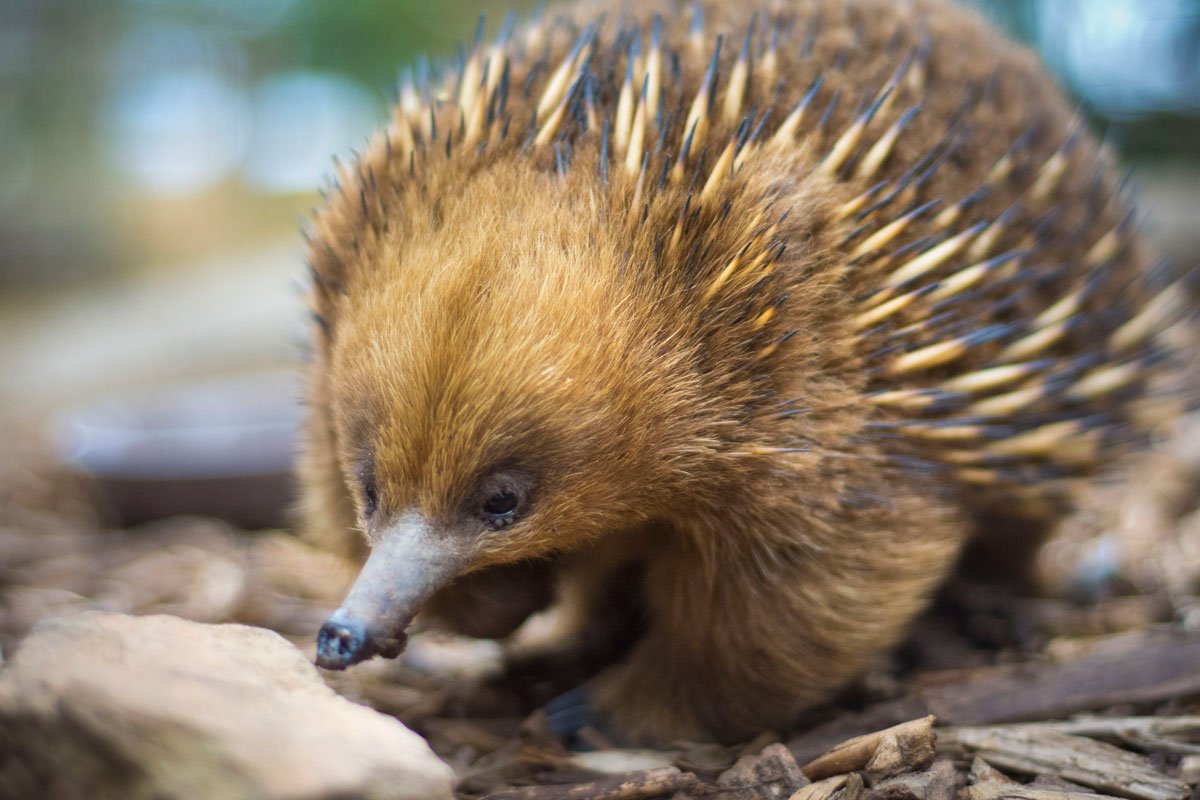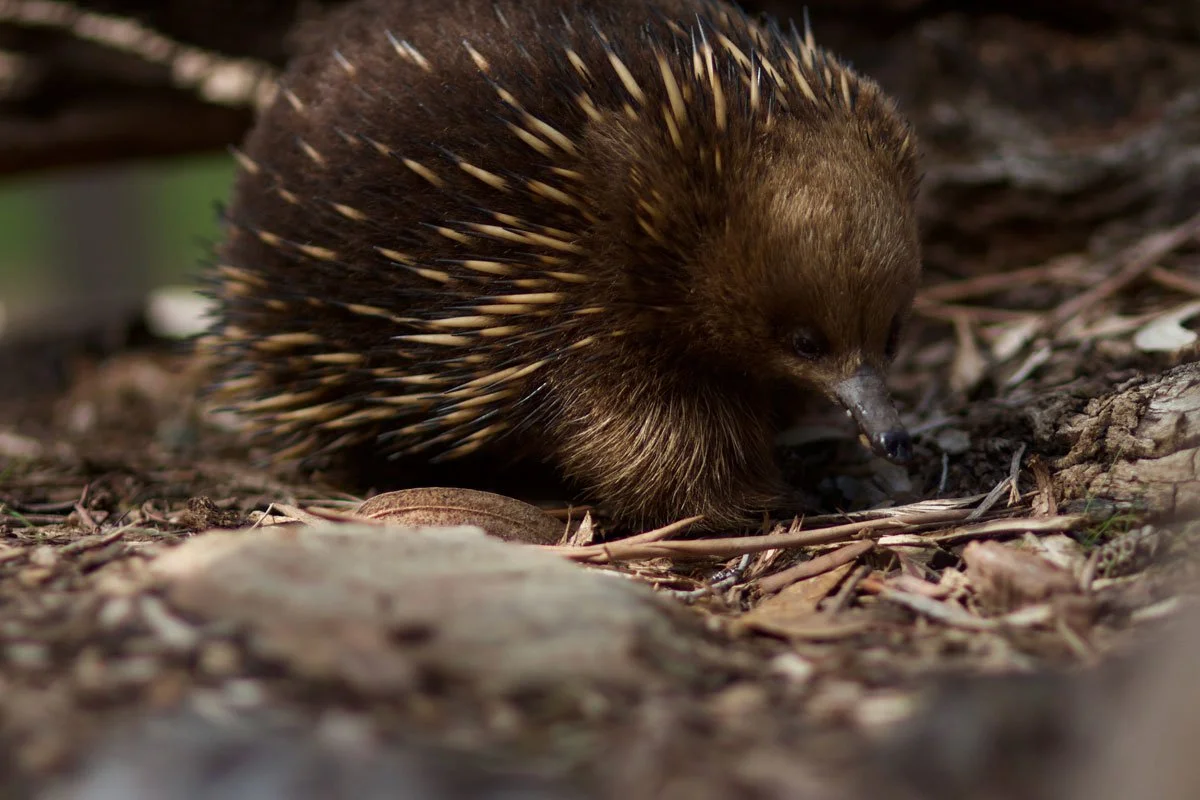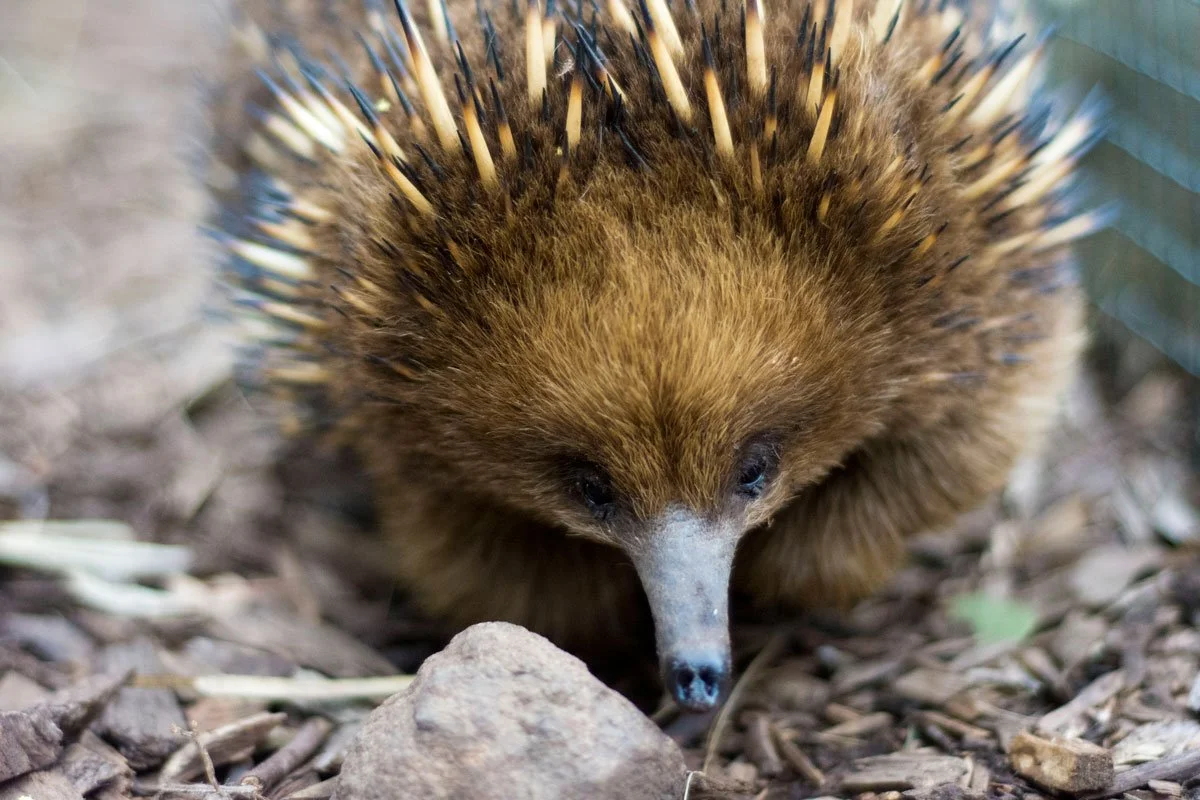Written for Bonorong by Pink Lemonade Social
Tasmanian Short-beaked Echidna
Tachyglossus aculeatus setosus
The short-beaked echidna, a cute, waddling, well-camouflaged creature is the most widespread native animal in Australia. There are five sub-species of short-beaked echidnas. The Tasmanian short-beaked echidna is a subspecies of the short-beaked echidna, which is endemic to Tasmania. Their Latin name translates to 'quick tongue' (Tachyglossus), 'spiny' (aculeatus), and ‘longer fur’ (setosus) which blends into their spines. In the wild, the lifespan is believed to be between 10 and 50 years, and up to 50 years in captivity.
Short-beaked Echidnas can reach 30-40cm in length and weigh up to 6kg, but the majority of them weigh between 2 and 5kg. Echidnas have spines on their bodies that they use to defend themselves by burrowing/wedging themselves so that only their spiky side is outwards towards a predator (who will usually be deterred by the spines). Their large claws (in comparison to their body size) are used to claw into an insect nest, and their long, sticky tongues are used to eat the insects. They are mainly active at dusk and at night, however on overcast days, they can be seen roaming around. They are most active at night and early morning, though may be active during the day.
The echidna is a monotreme, or an animal that lays eggs. Echidnas (4 species) and platypuses are the only monotremes in existence. Interestingly, the Short-beaked Echidna is one of the planet's oldest mammals, thought to have coexisted with dinosaurs up to 110 million years ago!
The earliest written description of an echidna was published in 1792 by Captain Bligh, in the ship's log of the Providence, which made a halt in Tasmania on its way to Tahiti. The Tasmanian short-beaked echidna was named by Étienne Geoffroy Saint-Hilaire in 1803 based on two specimens, one of which was discovered on or near Bruny Island.
The echidna is known as one of Australia's most famous animals, with its charming waddle, spiky skin, and shy demeanour, but how much do you really know about them? Here at Bonorong Wildlife Sanctuary, we have compiled a complete guide to the short-beaked echidna, and next time you visit you can meet our resident echidnas Randall and Luigi.
Tasmanian Short-beaked Echidna Size, Appearance & Description
Tasmanian short-beaked echidnas can crack open logs and termite mounds because their snouts (called beaks) are hard and robust. Echidnas have a keen sense of smell, which they use to locate potential mates, identify danger, and snuff out food. Their nose has mechanoreceptors and electroreceptors making them adept at sourcing food. Their mouths have no teeth, instead using a hard palate made of keratin to help consume food.
Their bodies are stocky, with no visible neck, with short hair behind their 5cm-long spines, which allows them to live in a variety of habitats. Their short limbs are held horizontally to their body and their shovel-like claws are suited for digging and burrowing in the dirt. Males have a spur on each hind leg, but unlike the Platypus, it is non-venomous. It is this that is used to determine the sex and age. Instead of the spur, they use their stiff, sharp spines to defend themselves.
Although they have little development of the outer ear known as the pinna, they have great hearing and can be startled easily.
Tasmanian Short-beaked Echidna Habitat & Location
From alpine mountains through tropical rainforests to dry zones and deserts, all terrestrial environments are habitats of the short-beaked echidna. Echidnas are shy and rarely seen, however they may be found throughout all of Australia, and as mentioned above, are the country's most numerous native mammal. Echidnas dig into the soil, hide under plants, and seek cover in hollow logs, rock crevices, and wombat or rabbit tunnels to escape inclement weather.
Interestingly, echidnas are surprisingly good swimmers. They've been spotted crossing rivers and beaches with their snouts in the air, as if they were snorkelling!
Echidnas are solitary, wandering creatures with extensive, overlapping home ranges (up to 50 hectares) and a stable location only when rearing their young in burrows. With an incredible sense of direction, it is important that echidnas that are rescued and rehabilitated are returned to their home ranges.
They have a core body temperature of 30-32 degrees Celsius (86-90 degrees Fahrenheit), but they can control it down as low as 5 degrees Celsius (41 degrees Fahrenheit) in a sort of hibernation called ‘torpor’ in which they reduce their heart rate to less than one beat per minute! Because of their low body temperature, they begin to hibernate as winter approaches. The best time to breed is in the spring, when the weather begins to warm up. They are more likely to be sighted in the cooler months in warmer regions, and in warmer months in cooler regions; all of this is a consequence of a body temperature range and control mechanism that is more reptile than mammalian.
Tasmanian Short-beaked Echidna Diet & Feeding
The Genus "tachy" meaning fast (think tachometer for measuring engine speed or tachycardia for an accelerated heart rate) and "glossus" meaning tongue, refers directly to the echidnas feeding behaviour; their tongues can protrude 18cm from the tip of the snout when feeding, lapping up ants, termites, and other insects at a rate of over 100 "flicks" per minute.
Adult echidnas mostly consume insects like ants and termites, but they will also eat other foods like earthworms, beetles, and moth larvae. They crush their food between their tongues and the floors of their mouths since they lack the teeth necessary for proper chewing. Their droppings are tinged with earth because their tongues are so sticky and effective that they unwittingly eat a lot of dirt when feeding.
Tasmanian Short-beaked Echidna Breeding & Reproduction
Tasmanian Short-beaked Echidnas are monotremes, meaning their young are hatched from eggs, not live-born like mammals. The female lays an egg that is as tough as leather. The typical gestation is 21-22 days, resulting in a single egg laid directly into the pouch. Ten days later, the baby echidna, called a puggle, which weigh approximately 0.3-2.0 g (0.05-0.07 oz) and the size of a jelly-bean, hatch. In contrast to other animals, echidnas only create their pouch temporarily by contracting their abdominal muscles. The ability to produce this abdominal pocket is shared by both sexes, which led to an early overestimate of female population numbers. The young spend about 45 days in the pouch, during which time they feed from a special patch of hairs on the mother's belly that they call a "milk patch. Mother echidnas lack nipples to feed the young, instead, newborns feed from a skin patch (milk is expelled from milk glands, through pore openings). Puggles leave the pouch after they develop spines, which takes about three months. When her young become too big for her to comfortably carry, the mother creates a nursery burrow underground. Babies stay with their mothers and nurse during the first six months of their lives. Unlike during hibernation, mothers lose more body mass during the first few weeks of early nursing because they are confined to their nursery burrow, which they keep at a stable temperature. However, once lactating mothers resume feeding, they are able to bring a young to maturity on a milk-only diet, reaching a weight of about 1.5kgs, while also gaining the same amount of weight for themselves. The mother may abandon her offspring for as long as five days at a time.
Young echidnas start foraging independently while their mothers are still nursing, suggesting that weaning is not a sudden process, and is usually between 140-210 days. When the young are weaned, the mother no longer visits the burrow, so they must rely on their own wits and instincts for food, shelter, and safety. Despite young echidnas staying within their mother's home range for the first 12 months of their lives, there appear to be no ongoing links between mothers and young once they are weaned and exit the nursery burrow. Reproduction in echidnas is coordinated with the ecosystem so that young can be weaned when food supplies are at their peak.
Echidnas reach sexual maturity at approximately 5 years old and females may only be able to wean a puggle once every four to six years.
The only time the short-beaked Echidna is seen in groups is during breeding season, otherwise they are solitary animals. Female Echidnas release a potent perfume termed a pheromone, luring in an ‘Echidna train’ of up to ten males (though typically just three to five). These processes can take several days and culminate in the last strongest male following the female & mating with the female.
Tasmanian Short-beaked Echidna Conservation Status
Short-beaked echidnas are not endangered, and are classified as least concern by the International Union for Conservation of Nature (IUCN), due to their numbers being plentiful in the wild.
Where to see an Echidna in Tasmania?
Due to their varied habitats, echidnas can be found all over Australia, and all over Tasmania. However, you are guaranteed to see these cute furry creatures here at Bonorong in Tasmania, and we have many different experiences include the ability to feed our resident echidnas
Tasmanian Short-beaked Echidna Threats
Echidnas are most at risk from the destruction and removal of their natural environment, specifically dead trees, stumps, and undergrowth being removed. Due to their sluggish pace, they are often struck by passing automobiles.
Echidnas don't have many natural predators and this topic has not been researched thoroughly. However, cats, dingoes, giant goannas & Tasmanian devils might consume juveniles or young adults. Non-native predators are canines and foxes.
As a defence mechanism, echidnas can curl into a ball (if on hard ground), wedge themselves into a log or rock crevice, or hastily dig a shallow trench, leaving only their spines visible.
Although echidnas are some of the most common animals in Tasmania and Australia, if you find injured or orphaned echidna or other wildlife, remember to call the Bonorong Wildlife Rescue Service, which operates 24/7 on 0447 264 625 / 0447ANIMAL.
Tasmanian Short-beaked Echidna Interesting Facts
· One of the few mammals that lays eggs (along with the platypus)
· Echidnas are regarded as "escape artists" in captivity because of their remarkable strength for their size (they can lift objects as heavy as a refrigerator!). They are also superb climbers.
· To clean the area between the spines, they use the claws on their rear feet like a comb and rotate their hind feet outward.
· Extremely long-lived relative to their size
· Have the slowest metabolism of any mammal
· Can escape wildfires by hiding underground, cooling off, and lowering their metabolism
· One of only two mammal species known to hibernate throughout their pregnancies; (the other is the bat)
· The penis structure of males is unique among mammals, they have a four-headed penis
· Their nose is sensitive to electromagnetic fields
· The snout can be used as a snorkel!
· They aat about 40,000 ants and termites a day.
· Their core body temperature is the second lowest of all mammals.
· Maximum Echidna Speed Is 2.3 km per hour, though they typically travel at around 1 km/h
· It is estimated that each echidna moves an average of 200 cubic metres of soil every year by digging.









